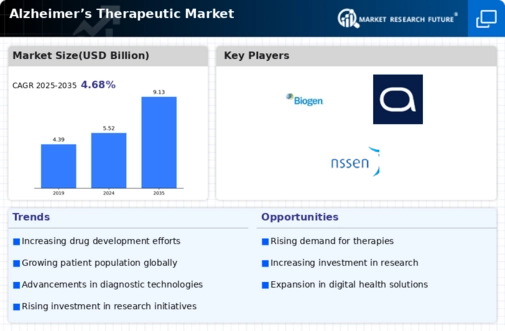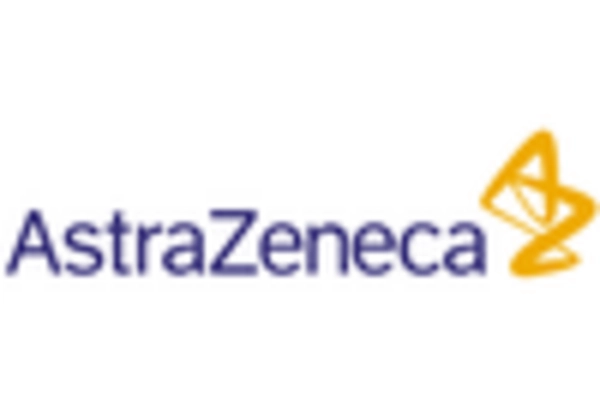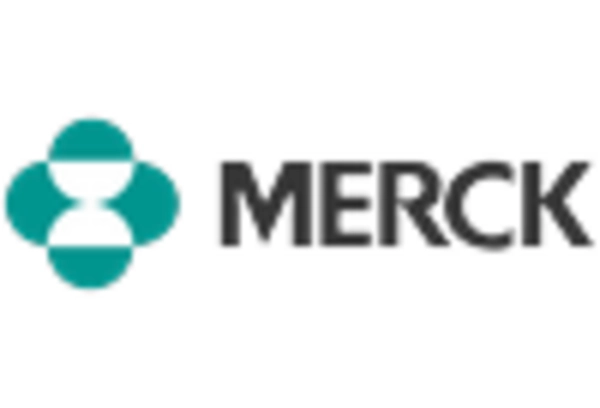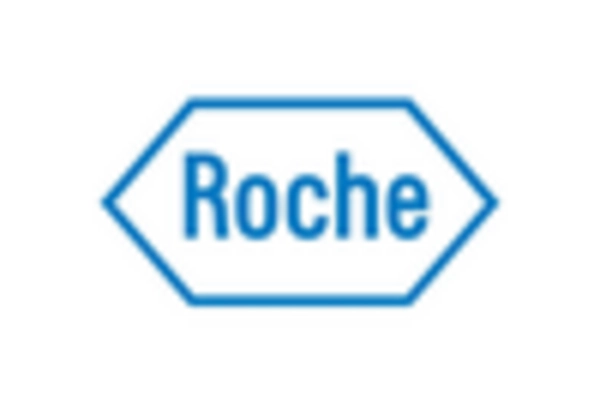Market Growth Projections
The Global Alzheimer’s Therapeutic Market Industry is poised for substantial growth, with projections indicating a rise from 5.52 USD Billion in 2024 to 9.13 USD Billion by 2035. This growth trajectory reflects a compound annual growth rate (CAGR) of 4.68% from 2025 to 2035. Factors contributing to this expansion include the rising prevalence of Alzheimer’s disease, advancements in research and development, and increased government funding. As the market evolves, it is expected to attract significant investments, fostering innovation and the development of new therapeutic options that address the needs of an aging population.
Growing Awareness and Education
Growing awareness and education regarding Alzheimer’s disease are vital drivers for the Global Alzheimer’s Therapeutic Market Industry. Increased public knowledge about the symptoms and early signs of Alzheimer’s is leading to earlier diagnoses and, consequently, a higher demand for therapeutic interventions. Educational initiatives by health organizations are empowering caregivers and families to seek medical advice sooner, which may enhance treatment outcomes. As awareness continues to rise, the market is likely to experience a surge in demand for both pharmacological and non-pharmacological therapies, thereby contributing to the projected CAGR of 4.68% from 2025 to 2035.
Government Initiatives and Funding
Government initiatives and funding play a pivotal role in shaping the Global Alzheimer’s Therapeutic Market Industry. Various national health agencies are increasingly prioritizing Alzheimer’s research, leading to enhanced funding for clinical trials and innovative treatment development. For instance, the National Institutes of Health in the United States has allocated substantial resources to Alzheimer’s research, which is expected to stimulate advancements in therapeutic options. This financial support not only encourages the development of new drugs but also facilitates public awareness campaigns aimed at early diagnosis and intervention, ultimately contributing to market growth.
Advancements in Research and Development
Ongoing advancements in research and development are crucial for the Global Alzheimer’s Therapeutic Market Industry. Innovative approaches, including the exploration of disease-modifying therapies and biomarker identification, are gaining traction. These developments may lead to the introduction of novel drugs that could alter the disease's progression. As the market evolves, the projected growth from 5.52 USD Billion in 2024 to 9.13 USD Billion by 2035 indicates a robust pipeline of potential therapies. Furthermore, collaborations between pharmaceutical companies and academic institutions are fostering a conducive environment for breakthroughs, which could significantly enhance treatment options for patients.
Rising Prevalence of Alzheimer’s Disease
The increasing prevalence of Alzheimer’s disease globally serves as a primary driver for the Global Alzheimer’s Therapeutic Market Industry. As populations age, the incidence of Alzheimer’s is projected to rise significantly. By 2024, the market is expected to reach 5.52 USD Billion, reflecting the urgent need for effective therapeutic solutions. The World Health Organization indicates that the number of people living with dementia is expected to triple by 2050, which underscores the growing demand for innovative treatments. This trend is likely to propel investments in research and development, thereby expanding the therapeutic options available in the market.
Emerging Technologies in Treatment Delivery
Emerging technologies in treatment delivery are reshaping the Global Alzheimer’s Therapeutic Market Industry. Innovations such as telemedicine and digital health platforms are facilitating better access to care for patients. These technologies enable healthcare providers to monitor patients remotely and adjust treatment plans in real-time, which may enhance patient adherence to therapy. The integration of artificial intelligence in drug discovery is also promising, potentially leading to more effective therapeutic options. As these technologies evolve, they are likely to contribute to the overall growth of the market, aligning with the increasing demand for personalized and accessible Alzheimer’s treatments.

















Leave a Comment